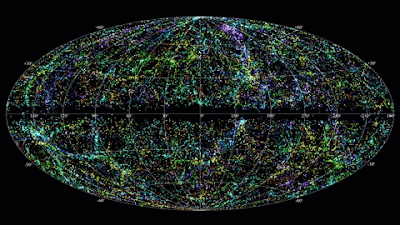 |
| An animation shows the random appearance of fast radio bursts (FRBs) across the sky. (Image: © NRAO Outreach/T. Jarrett (IPAC/Caltech); B. Saxton, NRAO/AUI/NSF) |
Topics: Astronomy, Astrophysics, Radio Astronomy, Research, Space Exploration
“Curiouser and curiouser!” Cried Alice (she was so much surprised, that for the moment she quite forgot how to speak good English).”
― Lewis Carroll, Alice's Adventures in Wonderland & Through the Looking-Glass
HONOLULU — Mysterious ultra-fast pinpricks of radio energy keep lighting up the night sky and nobody knows why. A newly discovered example of this transient phenomenon has been traced to its place of origin — a nearby spiral galaxy — but it's only made things murkier for astronomers.
The problem concerns a class of blink-and-you'll-miss-them heavenly events known as fast radio bursts (FRBs). In a few thousandths of a second, these explosions produce as much energy as the sun does in nearly a century. Researchers have only known about FRBs since 2007, and they still don't have a compelling explanation regarding their sources.
"The big question is what can produce an FRB," Kenzie Nimmo, a doctoral student at the University of Amsterdam in the Netherlands, said during a news briefing on Monday (Jan. 6) here at the 235th meeting of the American Astronomical Society in Honolulu, Hawaii.
FRB 180916.J0158+65, as the object is known, is a repeating FRB discovered by the Canadian Hydrogen Intensity Mapping Experiment (CHIME) observatory, a radio telescope near Okanagan Falls in British Columbia that Nimmo called "the world's best FRB-finding machine."
Follow-up observations by a network of telescopes in Europe allowed the research team to produce a high-resolution image of the FRB's location. This location turned out to be a medium-sized spiral galaxy like our Milky Way that is surprisingly nearby, only 500 million light-years away, making it the closest-known FRB to date. The results were published yesterday (Jan. 6) in the journal Nature.
Origin of Deep-Space Radio Flash Discovered, and It's Unlike Anything Astronomers Have Ever Seen
Adam Mann, Live Science
#P4TC links:
FRBs...December 7, 2015
Fast Radio Bursts and Missing Matter...February 25, 2016
ET, FRBs and Light Sails...March 13, 2017
Comments